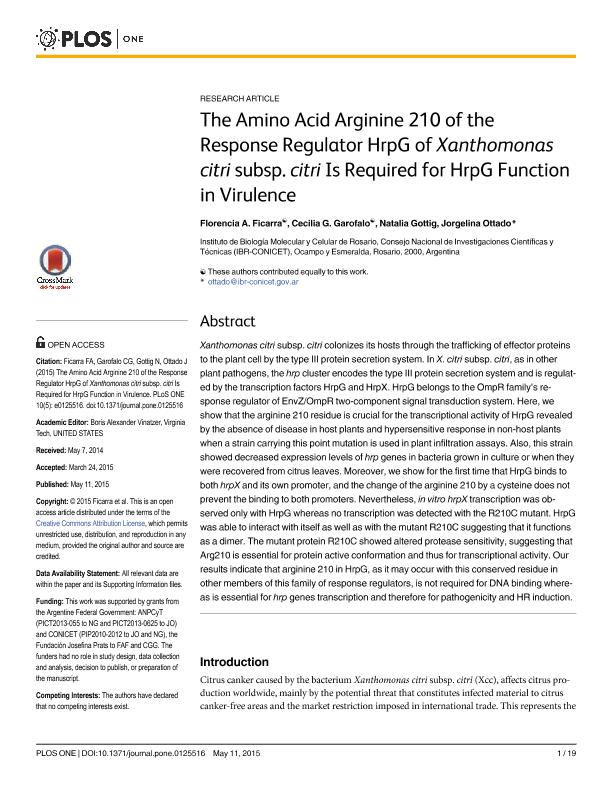Mostrar el registro sencillo del ítem
dc.contributor.author
Ficarra, Florencia Andrea

dc.contributor.author
Garofalo, Cecilia Graciela

dc.contributor.author
Gottig Schor, Natalia

dc.contributor.author
Ottado, Jorgelina

dc.date.available
2017-07-26T18:42:39Z
dc.date.issued
2015-05
dc.identifier.citation
Ficarra, Florencia Andrea; Garofalo, Cecilia Graciela; Gottig Schor, Natalia; Ottado, Jorgelina; The Amino Acid Arginine 210 of the Response Regulator HrpG of Xanthomonas citri subsp. citri Is Required for HrpG Function in Virulence; Public Library Of Science; Plos One; 10; 5; 5-2015; 1-19; e0125516
dc.identifier.issn
1932-6203
dc.identifier.uri
http://hdl.handle.net/11336/21350
dc.description.abstract
Xanthomonas citri subsp. citri colonizes its hosts through the trafficking of effector proteins to the plant cell by the type III protein secretion system. In X. citri subsp. citri, as in other plant pathogens, the hrp cluster encodes the type III protein secretion system and is regulated by the transcription factors HrpG and HrpX. HrpG belongs to the OmpR family’s response regulator of EnvZ/OmpR two-component signal transduction system. Here, we show that the arginine 210 residue is crucial for the transcriptional activity of HrpG revealed by the absence of disease in host plants and hypersensitive response in non-host plants when a strain carrying this point mutation is used in plant infiltration assays. Also, this strain showed decreased expression levels of hrp genes in bacteria grown in culture or when they were recovered from citrus leaves. Moreover, we show for the first time that HrpG binds to both hrpX and its own promoter, and the change of the arginine 210 by a cysteine does not prevent the binding to both promoters. Nevertheless, in vitro hrpX transcription was observed only with HrpG whereas no transcription was detected with the R210C mutant. HrpG was able to interact with itself as well as with the mutant R210C suggesting that it functions as a dimer. The mutant protein R210C showed altered protease sensitivity, suggesting that Arg210 is essential for protein active conformation and thus for transcriptional activity. Our results indicate that arginine 210 in HrpG, as it may occur with this conserved residue in other members of this family of response regulators, is not required for DNA binding whereas is essential for hrp genes transcription and therefore for pathogenicity and HR induction.
dc.format
application/pdf
dc.language.iso
eng
dc.publisher
Public Library Of Science

dc.rights
info:eu-repo/semantics/openAccess
dc.rights.uri
https://creativecommons.org/licenses/by-nc-sa/2.5/ar/
dc.subject
Xanthomonas
dc.subject
Citrus
dc.subject
Canker
dc.subject.classification
Biología Celular, Microbiología

dc.subject.classification
Ciencias Biológicas

dc.subject.classification
CIENCIAS NATURALES Y EXACTAS

dc.title
The Amino Acid Arginine 210 of the Response Regulator HrpG of Xanthomonas citri subsp. citri Is Required for HrpG Function in Virulence
dc.type
info:eu-repo/semantics/article
dc.type
info:ar-repo/semantics/artículo
dc.type
info:eu-repo/semantics/publishedVersion
dc.date.updated
2016-11-24T19:36:48Z
dc.journal.volume
10
dc.journal.number
5
dc.journal.pagination
1-19; e0125516
dc.journal.pais
Estados Unidos

dc.journal.ciudad
San Francisco
dc.description.fil
Fil: Ficarra, Florencia Andrea. Consejo Nacional de Investigaciones Científicas y Técnicas. Centro Científico Tecnológico Conicet - Rosario. Instituto de Biología Molecular y Celular de Rosario. Universidad Nacional de Rosario. Facultad de Ciencias Bioquímicas y Farmacéuticas. Instituto de Biología Molecular y Celular de Rosario; Argentina
dc.description.fil
Fil: Garofalo, Cecilia Graciela. Consejo Nacional de Investigaciones Científicas y Técnicas. Centro Científico Tecnológico Conicet - Rosario. Instituto de Biología Molecular y Celular de Rosario. Universidad Nacional de Rosario. Facultad de Ciencias Bioquímicas y Farmacéuticas. Instituto de Biología Molecular y Celular de Rosario; Argentina
dc.description.fil
Fil: Gottig Schor, Natalia. Consejo Nacional de Investigaciones Científicas y Técnicas. Centro Científico Tecnológico Conicet - Rosario. Instituto de Biología Molecular y Celular de Rosario. Universidad Nacional de Rosario. Facultad de Ciencias Bioquímicas y Farmacéuticas. Instituto de Biología Molecular y Celular de Rosario; Argentina
dc.description.fil
Fil: Ottado, Jorgelina. Consejo Nacional de Investigaciones Científicas y Técnicas. Centro Científico Tecnológico Conicet - Rosario. Instituto de Biología Molecular y Celular de Rosario. Universidad Nacional de Rosario. Facultad de Ciencias Bioquímicas y Farmacéuticas. Instituto de Biología Molecular y Celular de Rosario; Argentina
dc.journal.title
Plos One

dc.relation.alternativeid
info:eu-repo/semantics/altIdentifier/doi/http://dx.doi.org/10.1371/journal.pone.0125516
dc.relation.alternativeid
info:eu-repo/semantics/altIdentifier/url/http://journals.plos.org/plosone/article?id=10.1371/journal.pone.0125516
Archivos asociados
